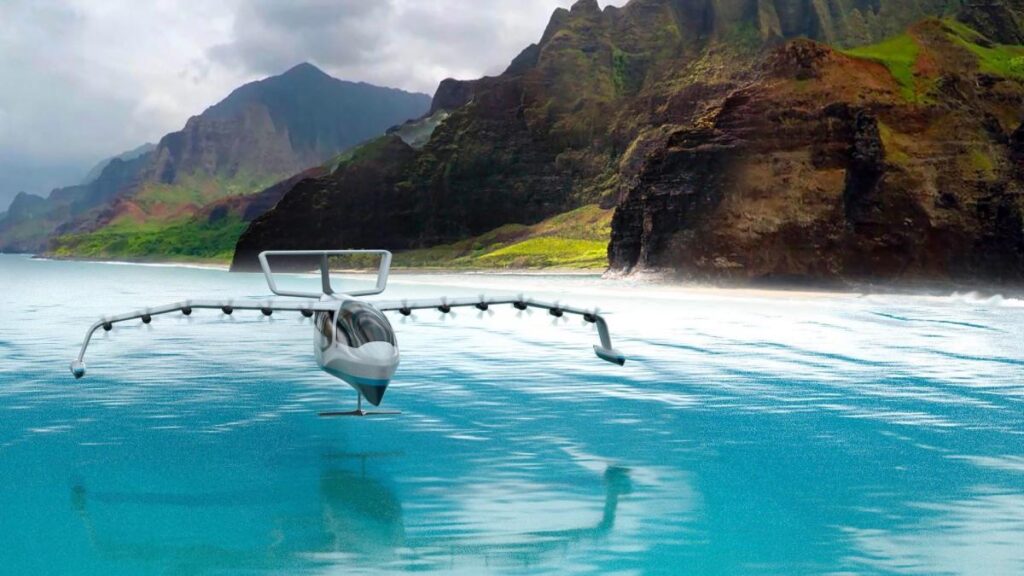Commuters and tourists may soon be able to island-hop aboard sustainable seagliders with the mesmerizing speed of graceful aquatic insects, thanks to a groundbreaking partnership with Alaska Airlines.
what's happening?
In January 2024, a coalition of stakeholders helped launch the Hawaii Seaglider Initiative, a program that aims to modernize Hawaii’s maritime transportation network and provide reliable clean energy solutions to protect and minimize disruption to the islands’ sacred, biodiverse ecosystems.
Alaska Airlines, which has announced plans to merge with Hawaiian Airlines in late 2023, is one of the partners working with innovative developer Regent to bring the all-electric, 12-seater Seaglider to market.
Unlike traditional fixed-wing aircraft, the SeaGlider operates in three modes: hover mode (when leaving the dock), hydrofoil mode (when gaining speed), and flight mode (when reaching open ocean). Regent says the SeaGlider is also quiet and has a range of more than 180 miles. The company estimates that next-generation batteries will increase the range to 500 miles on a single charge.
With a cruising speed of approximately 180 miles per hour, seagliders can transport travelers and supplies to inter-island destinations quickly and safely.
Why is this encouraging?
First, it should make inter-island travel more affordable: According to the Hawaii Seaglider Initiative, these aircraft have lower operating costs and simpler infrastructure (water is a great natural runway, for example), which should bring down prices for travelers.
Check it out now: Can this concentrate replace all the toxic cleaning chemicals in your home?
According to a press release about the initiative, a feasibility study for the route predicts that one-way tickets could be purchased for just $30, which would be great for travelers and commuters and a boon for critical infrastructure like freight and food shipments, medical facilities, and more.
Second: It brings us one step closer to sustainable travel. The aviation industry is estimated to be responsible for 2.5% of global carbon pollution, a figure that's expected to rise as more people around the world take to air travel. In contrast, the Seaglider is fully electric, so it doesn't emit the same harmful pollutants while flying.
“Alaska Airlines is proud to support and learn from the Hawaii Seaglider Initiative, which provides important information about the benefits seagliding brings to local communities,” Pasha Saleh, Alaska Airlines director of corporate development, said in an email.
“Alaska has an ambitious goal of becoming net-zero carbon by 2040, and to achieve that goal we must look to future technologies like what Regent is doing with their seagliders. … We look forward to working with them to reimagine the future of aviation,” Saleh said.
What is Alaska Airlines' overall sustainability plan?
The airline is the fifth largest airline in the United States and is one of the airlines making major moves in the area of sustainability.
Alaska Airlines has already launched its Sustainable Aviation Fuel Program, making it easy for individual travelers to join the industry's largest effort to reduce carbon pollution. The program rewards elite qualifying miles (e.g. seat upgrades) to Mileage Plan members who purchase sustainable aviation fuel credits.
Additionally, on a day-to-day level, the airline's 2023 Impact Report revealed that allowing customers to pre-order meals before their flight has reduced food waste by 61% compared to 2019, preventing approximately 460,000 meals from being wasted that could have rotted in landfills and produced methane.
Other environmentally friendly initiatives include a partnership with the Surfrider Foundation, which runs programs such as beach cleanups and raising awareness about the problem of plastic waste.
Conclusion: While the seaglider technology is still in the development and testing stage, its launch in mid-decade marks an important step toward more affordable and sustainable transportation, especially in waters like the Hawaiian Islands.
Sign up for our free newsletter to get the latest on the coolest innovations every week. Improving Lives and Save the planet.

